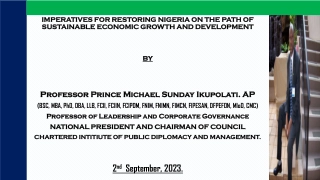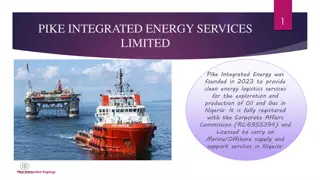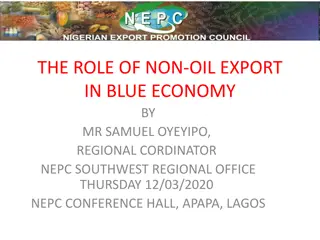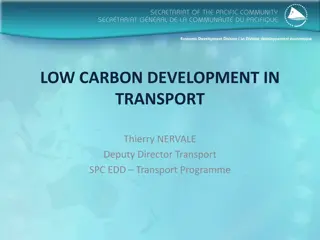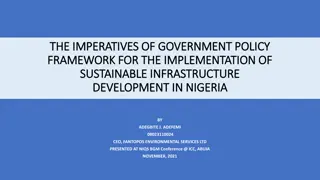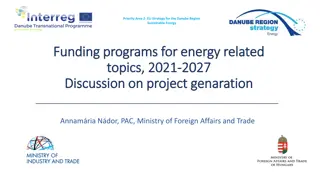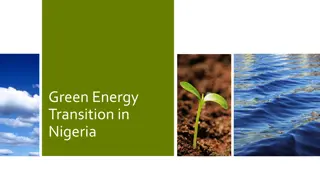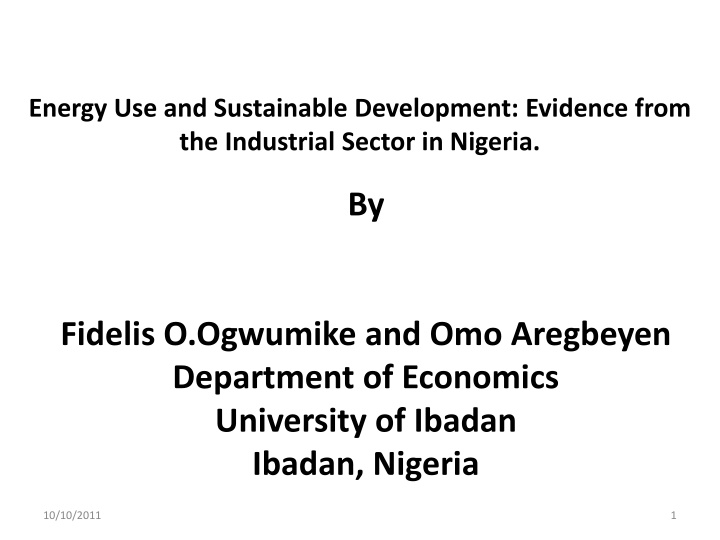
Energy Use and Sustainable Development in Nigeria
This paper explores the nexus between energy use and sustainable development, emphasizing the importance of energy efficiency in industrial sectors in Nigeria. It discusses the environmental impacts of energy production and highlights barriers to adopting energy-efficient technologies in developing countries. The study aims to advocate for the integration of energy-efficient practices for economic and environmental benefits.
Download Presentation

Please find below an Image/Link to download the presentation.
The content on the website is provided AS IS for your information and personal use only. It may not be sold, licensed, or shared on other websites without obtaining consent from the author. If you encounter any issues during the download, it is possible that the publisher has removed the file from their server.
You are allowed to download the files provided on this website for personal or commercial use, subject to the condition that they are used lawfully. All files are the property of their respective owners.
The content on the website is provided AS IS for your information and personal use only. It may not be sold, licensed, or shared on other websites without obtaining consent from the author.
E N D
Presentation Transcript
Energy Use and Sustainable Development: Evidence from the Industrial Sector in Nigeria. By Fidelis O.Ogwumike and Omo Aregbeyen Department of Economics University of Ibadan Ibadan, Nigeria 10/10/2011 1
Outline of the Presentation The focus of the Paper Energy and Sustainable Development Nexus Materials and Methods Company Information and Main Products Findings Policy Implications from the Study Conclusion and Recommendation(s) 10/10/2011 2
The Focus of the Paper Like capital, labour and knowledge, energy is one of the main factors affecting economic development. The substantial rate of growth of World industrial energy use along with increase in environmental problems have prompted responses aimed at reducing energy use or enhancing energy efficiency especially in the industries. If energy efficiency pays, why is it not happening in developing countries? This paper provides insights into this question with firm level evidence-based information from the industrial sector in Nigeria. The intention is to make case for the adoption of industrial energy efficient technologies and practices in developing countries in general, and Nigeria in particular. 10/10/2011 3
Energy and Sustainable Development Nexus The important connection between energy and sustainable development concerns the environmental dimension in terms of the relationship between energy extraction, processing and use, and environmental quality. There is no energy production or conversion technology without risk or without waste. Somewhere along all energy chains from resource extraction to the provision of energy services pollutants are produced, emitted or disposed of, often with severe health and environmental impacts. Even if a technology does not emit harmful substances at the point of use, emissions and wastes may be associated with its manufacture or other parts of its life cycle. The requisite of sustainable development is that the production and use of energy should not endanger the quality of life of current and future generations and should not exceed the carrying capacity of ecosystems. One obvious solution is to use energy more efficiently. That means consuming less energy to produce goods and services, environmental-friendly new behaviours and working methods, coupled with the use of new technologies that offer better energy performance. It is widely acknowledged as the fastest, cheapest, and cleanest way. Apart from the environmental and social benefits of energy (use) efficiency, there are also financial/economic benefits. However, there are a number of barriers to adoption of energy-efficient technologies, especially by firms. These barriers include willingness to invest, information and transaction costs, profitability barriers, lack of skilled personnel , and slow capital stock turnover. In addition the decision-making process regarding investments in energy-efficient technologies is shaped by firm rules, corporate culture, and the company s perception of its level of energy efficiency 10/10/2011 4
Materials and Methods Information was obtained from a sample of Nigerian manufacturing companies located in Lagos state (the commercial capital of the country) across four sectoral groupings, namely food, textile, iron and steel, and others. From each sectoral group, the sample firms ranged from small, through medium to large scale enterprises. Sampled firms were probed for information about energy-use, energy efficiency and especially investment in energy efficiency and management. In collecting the required information, we specifically ask questions and sought information in respect of the followings: - level of information on energy efficiency; - awareness and knowledge about implementing energy efficiency projects; - conduct of external energy audit to discover areas where efficiency can be enhanced; - existence of active policy on identifying and repairing leakages such as air, heat and steam, through a combination of both internal and external energy audit; - investments in energy efficiency; -possession of clear information on energy efficiency options; and - availability of funds for investment in energy efficiency projects. On the spot visits were made to each firm s location, in-depth interviews were conducted and production facilities inspected. Inferences were drawn from observations and the narratives recorded during the interviews. 10/10/2011 5
Company Information and Main Products Food (4) A large manufacturer of food products, A large industrial conglomerate, and A medium sized beverages producing company A large brewing company Textlie (4) A medium sized textile company producing clothes and fabrics. A large textile company that uses 100% Nigerian cotton to spin and weave. The company employs over 3000 employees and the turnover last year was around 50 million euro. It exports to other Western African countries A small-scale textile company with a newly constructed production factory. The oldest of them established in 1970s manufactures quality sacks to support the industrial and agricultural market sectors of the Nigerian economy. Currently, this company has a capacity of 30million sacks per month, used to package powder and granular industrial products (Cement, Fertiliser, Flour, Sugar, Salt, Detergent, etc) Iron&Steel (2) A large iron and steel company with main activity of melting scrap metals into billets and rolling it into various sizes of iron rods. The company has 430 employees and all the end products are sold within Nigeria. The company is 80% owned by a foreign company. A large aluminium company. The product range encompasses Patterned & Stucco Coils, Color Coated Coils, Roofing Sheets, Cookware, Extruded Profiles & Flexible Packaging. Others. (3) A large paper mill company which manufactures and markets top quality paper products. A small-scale producer of safety glass. The company employs 120 workers and has a turnover of around 550.000 euro. A small company active in the fabrication and assembling of light fittings, fixtures & accessories. The company is planning to set up an assembling line for compact fluorescent lamps next year 10/10/2011 6
Findings The discussion of the findings of the study is organised around the major focus of the visits made to the firms production facilities and the interviews conducted. The focus to reiterate include: energy use and generation within the company; level of information on energy efficiency; awareness and knowledge about implementing energy efficiency projects; conduct of external energy audit to discover areas where efficiency can be enhanced; existence of active policy on identifying and repairing leakages through energy audit; investments in energy efficiency; possession of clear information on energy efficiency options; and availability of funds for investment in energy efficiency projects. The findings on each of these sub-themes are summarised and reported in Tables 1 & 2 as follows. 10/10/2011 7
Table 1: Summary Statistics on the Energy Use Efficiency and Management Practices among the Sampled Firms. Food Textile Iron& Steel Others 1 2 3 4 1 2 3 4 1 2 1 2 3 Energy Generation by self Level of information on energy efficiency Yes Yes Yes Yes Yes Yes Yes Yes Yes Yes Yes Yes Yes Adequate Low Low Low Adequate Low Low Low Low Low Low Low Low Awareness and knowledge about implementing energy efficiency projects High Low Moderate Moderate Moderate Low Moderate Low Low Low Low Low Low Conduct of external energy audit to discover areas where efficiency can be enhanced. Yes No No No No No Yes No No No No No No Existence of active policy on identifying and repairing leakages:- air, heat, steam, etc., through a combination of both internal and external energy audit Yes No No No No No Yes No No No No No No Investments in energy efficiency Yes No No Yes Yes No Yes Yes No No No No No Possession of clear information on energy efficiency options Yes No No No No No No No No No No No No Availability of funds for investment in energy efficiency projects. 10/10/2011 8 Yes No No Yes Yes No Yes Yes No No No No No
Table 2: Percentage Distribution of the Sampled Firms Energy-use Efficiency and Management Practices Profile across Subsectors. Total Assessment Criteria/Sub-Sector Food Textile Iron & Steel Others 100.0 Energy Generation by self Level of information on energy efficiency 100.0 100.0 100.0 100.0 15.4 25.0 25.0 0.00 0.00 Awareness and knowledge about implementing energy efficiency projects 38.5 75.0 50.0 0.00 0.00 Conduct of external energy audit to discover areas where efficiency can be enhanced. 15.4 25.0 25.0 0.00 0.00 Existence of active policy on identifying and repairing leakages 15.4 25.0 25.0 0.00 0.00 Investments in energy efficiency 38.5 50.0 75.0 0.00 0.00 Possession of clear information on energy efficiency options 7.7 25.0 0.00 0.00 0.00 Availability of funds for investment in energy efficiency projects. 38.5 50.0 75.0 0.00 0.00 10/10/2011 9
Highlights of Findings The general level of information in Nigeria on energy efficiency was low; very few companies have adequate awareness and knowledge about implementing energy efficiency projects; most companies have never carried out an external energy audit to determine areas where efficiency can be enhanced; most companies need active policy on identifying and repairing leakages such as air, heat and steam, through a combination of internal and external energy audit; the relative low price of fuel in Nigeria, combined with the high investment costs for machines result in long payback period for investments in energy efficiency; despite the major problem of energy supply facing the companies, a number of them have no clear information on energy efficiency options; and finance for investment in energy efficiency not readily available either from retained earnings or bank loans due mainly to the financial crisis. 10/10/2011 10
Highlights of Policy Implications from the Study Electricity from the national grid is heavily subsidised and does not give incentive for energy efficiency investment; High energy cost has adversely affected employment situation in the industry. Retrenchment of workers/reduction in number of shifts is always an easier way of reducing cost than other options such as energy efficiency; Energy reduction is another substitute for job reduction and both companies and government as well as development partners should be actively engaged in industrial energy efficiency options in developing countries; In some of the companies plants, many machines are very old and thus do not meet the highest energy efficiency standard; In some companies, lots of heat energy is generated as by-products but are not being reused at other parts of the plants but simply thrown away; National benchmarks for energy consumption in the various industrial processes are not available; Some of the companies expressed the need for external consulting, auditing and advice on energy efficiency opportunities; Possibility of joint production of power by companies is there but such independent power generation depends on reliable gas supply and competitive energy prices; Need for case studies and concrete measures which can be followed by companies to become more energy efficient. In other words, technological advice on energy efficient options will be very useful; The need to help in developing cases for small and medium scale power plants and providing information about industrial energy-use; Finance for investment in energy efficiency not readily available either from retained earnings or bank loans due mainly to the financial crisis; and Need for incentives or subsidies on investments in energy efficiency. Since companies pay fine for polluting the environment with generators, they should be rewarded for greening the environment with energy efficient machines/processes. 10/10/2011 11
Conclusion There exists a key policy challenge. The key policy challenge is the need to address the subsisting paradox where companies pay fine for polluting the environment with generators but are not rewarded for greening the environment with energy efficient machines/processes. The paper therefore recommends the need for incentives or subsidies on investments in energy efficiency. 10/10/2011 12


